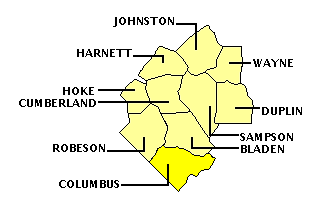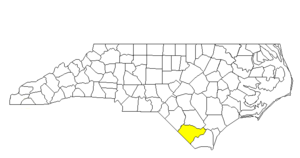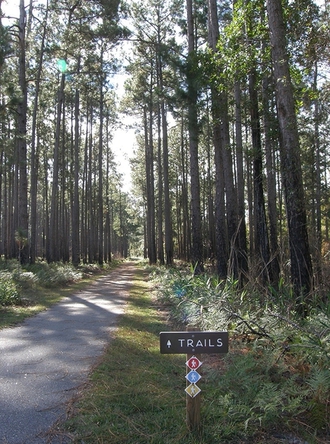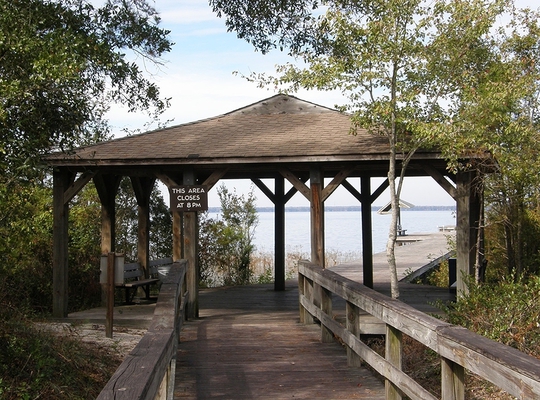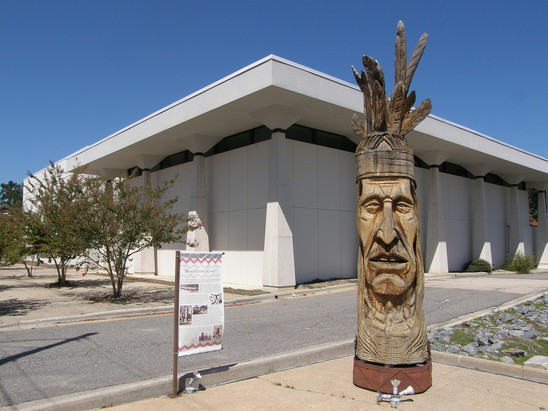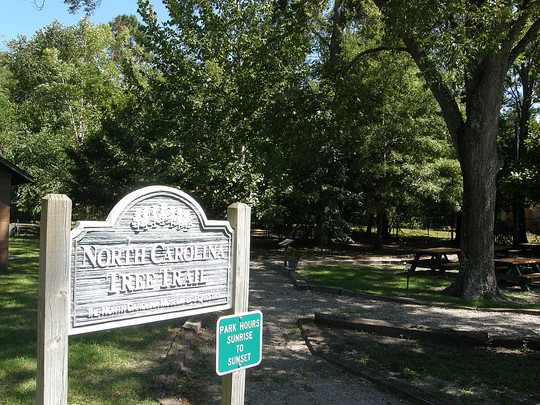COLUMBUS COUNTY
Scroll down this page or click on specific site name to view features the following Columbus County attractions/points of interest:
Fast facts about Columbus County:
Created in 1808, the county is named for Christopher Columbus, famed navigator and explorer.
The county seat is Whiteville, named for James B. White, a state senator. Other communities include Acme-Delco, Brunswick, Fair Bluff, and Tabor City.
Columbus County’s land area is 936.80 square miles; the population in the 2010 census was 58,098.
East of Whiteville
Lake Waccamaw State Park, about 30 miles due west of Wilmington, has several features that can be called unique. With 14 miles of shoreline, Lake Waccamaw is one of the largest natural lakes in the state, but in appearance it is little different in appearance than such nearby bodies of water as Jones Lake, Singletary Lake, or the more-commercialized White Lake. So what makes Waccamaw unique? The answer starts with the 12- to 15-foot limestone bluffs that rim the lake’s northern shore. The limestone run-off dramatically affects the acidity of the lake’s water. Unlike any bay lake in the state, Waccamaw’s tea-colored water has a neutral pH level. This encourages biodiversity; as a result there are several species of aquatic life that are unique. They include distinct plant or animal life found only in a small geographic region – such fish as the Waccamaw darter, silverslide and killifish; and such mollusks as the Waccamaw siltsnail, spike, fatmucket and amnicola. It’s not likely you’d ever spot one of these rare species on your own or even recognize them if you did, so an exhibit at the visitor center sheds light on these seldom-seen creatures. Sharp-eyed guests have a much better chance at spotting the rare Venus flytrap. This flesh-eating plant is native to a very small area in southeastern North Carolina. Other colorfully named, carnivorous rarities found around the lake include lavender bladderwort, pink sundew, yellow pitcher plants and blue-flower butterwort.
Such unusual plant and fish species aside, Lake Waccamaw State Park offers many of the same pleasant outdoor activities as most state parks centered on a lake, such as fishing, boating, hiking, picnicking and camping. The park encompasses 1,732 acres. Though there is no boat access in the park itself, two free public launch areas are nearby. The NC Wildlife Resources Commission stocks the lake with largemouth bass, bluegill and other fish. In all, 52 species of game and non-game fish are found at Lake Waccamaw. Hikers can choose from a variety of nature trails. The longest covers five miles. It follows the lake shore from the visitor center to the Waccamaw River, passing through stands of pine, cypress and hickory along the way. The park opens at 8 AM year-round; closing hours vary seasonally. The park is open daily except Christmas Day. Admission is free. 910-646-4748
Such unusual plant and fish species aside, Lake Waccamaw State Park offers many of the same pleasant outdoor activities as most state parks centered on a lake, such as fishing, boating, hiking, picnicking and camping. The park encompasses 1,732 acres. Though there is no boat access in the park itself, two free public launch areas are nearby. The NC Wildlife Resources Commission stocks the lake with largemouth bass, bluegill and other fish. In all, 52 species of game and non-game fish are found at Lake Waccamaw. Hikers can choose from a variety of nature trails. The longest covers five miles. It follows the lake shore from the visitor center to the Waccamaw River, passing through stands of pine, cypress and hickory along the way. The park opens at 8 AM year-round; closing hours vary seasonally. The park is open daily except Christmas Day. Admission is free. 910-646-4748
Whiteville
For a time, folks in Whiteville joked that the North Carolina Museum of Forestry might be the only museum in the country with its own drive-thru window. That’s because the facility occupies a former bank building. When the Museum first opened in July, 2000, the drive-thru was put to good use on special occasions, with thousands of pine tree seedlings having been passed out to motorists. Although the novelty of the drive-thru has come to an end, thanks to a recent renovation, visitors really needed to go inside anyway to see everything the museum has to offer. The bank vault, for example, has been cleverly converted into the “Piney Woods” exhibit, home to a mounted black bear, raccoon, and fox.
Among the Museum's exhibits is its collection of tree slabs, referenced historically as “timber planks.” The Whiteville facility has a total of 49 slabs, all of which came from a larger collection gathered across North Carolina in 1892 by W. W. Ashe and Gifford Pinchot. Pinchot later became the First Chief of the U. S. Forest Service and would earn the sobriquet “Father of American Conservationism.” The slabs were part of an exhibit displayed at the Chicago World’s Fair of 1893 and are thought to be the first exhibit in the country to highlight practical scientific forestry. The timber planks were also exhibited at the Paris World’s Fair in 1900 and the St. Louis World’s Fair in 1904. In addition to those seen at the Whiteville museum, other slabs from this collection are exhibited at the NC Museum of Natural Science in Raleigh.
With a mandate to be the leader in research in the community, the Museum has sponsored local “archaeological digs,” one of which has uncovered the remains of a giant ground sloth. Such prehistoric creatures were covered with thick fur, stood erect on their hind legs, and weighed as much as three tons. Several vertebra, tooth fragments, and a claw are displayed. Examples of petrified wood found in the region are also exhibited. Behind the building is a small “Tree Trail,” showcasing examples of trees from the state’s three major geographical regions – coastal plains, piedmont, and mountains. Another of the facility’s outdoor attractions is the imposing, 20-foot “Whispering Giant” Indian head statue by artist Peter Wolf Toth. Carved in 2005 from bald cypress, it stands near the Museum entrance. From US 74 East, take the US 701 By-Pass south into Whiteville, turn left on Columbus, then right on Madison. The Museum is immediately on the left. Hours are 9-5 Monday-Friday, 1-4 Saturday, and 2-5 Sunday. Admission is free. 910-914-4185
Columbus County is bordered by BLADEN, BRUNSWICK (Region Three), PENDER (Region Three), and ROBESON counties.
Return to REGION FIVE HOME PAGE.
Return to GEOGRAPHIC REGIONS HOME PAGE.

